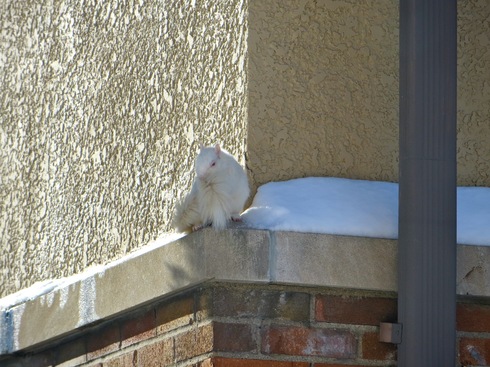Yesterday’s Tuesday Tweet featured an image of an albino Grackle. That is not the only image within the Bell Museum records that documents color abnormalities in animals. In the 1940s, museum taxidermist Walter Breckenridge prepared a mounted display of three gray squirrels. One of the squirrels exhibited the typical gray coloration, another was of a squirrel specimen that was afflicted with albinism, and a third squirrel displayed melanism.

– Squirrels, gray, showing melanism and albinism, circa 1940
“What is melanism?” I thought to myself as I entered the caption information on my metadata spreadsheet. An engaging Google search ensued.
Melanin, a pigment that gives dark coloration to hair and skin, is overdeveloped in animals that have melanism. For a scholarly scientific explanation, read “The genetic basis of melanism in the gray squirrel (Sciurus carolinensis)” by McRobie and Thomas.
On the occasion that I am introduced to an unfamiliar topic while managing the Exploring Minnesota’s Natural History project I have more than just the search capabilities of Google at my disposal. I can also turn to my subject matter expert – a biologist and animal enthusiast who also happens to be a childhood friend.
I am most comfortable scrolling through census records and transcribing 19th century handwriting. LaToshia, on the other hand, has a degree in biology and spent several years working with manatees at a marine research station in Florida and later trained and cared for elephants at Busch Gardens.
Each time I come across a new and previously unknown (to me) fact about the animal world, I ask the expert. Such was the case with the image of the nictitating membrane of an owl I encountered back in October. My latest discovery also resulted in an email to my longtime friend. “LaToshia, Did you study melanism in your biology coursework?“
She replied with an experience she had when she worked at the Mote Marine Laboratory:
“We had a turtle at Mote who was amelanistic, (she wasn’t a true albino). Years ago she had come in as a hatchling and someone decided to keep her because she would have been picked off in the wild (she also had a myriad of health problems related to the genetics of it). We had hundreds of hatchlings come in every year and there was a time or two another like her would come in.”
For a picture and to read more about this turtle, Edgar, visit the Mote Aquarium website.
Now back to squirrels. The weekend after I saw the image of Breckenridge’s mounted gray squirrels from the Bell Museum records I was looking out the window in my apartment and saw an albino squirrel sitting on an adjacent building.
That’s nuts!
